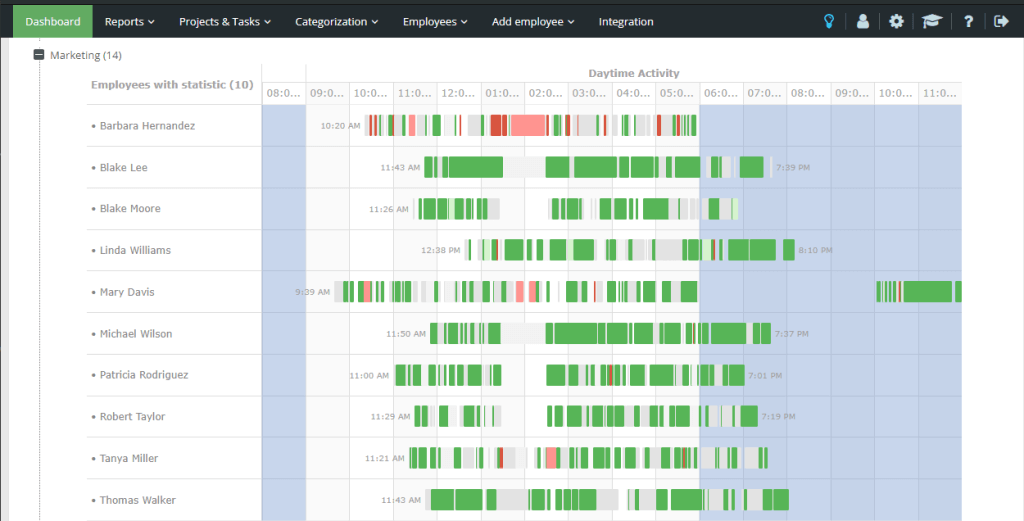Burnout doesn't start with an email saying “I'm tired.” It accumulates invisibly. In most companies, HR only recognizes the problem once key people are already planning their exit. This delay costs time, resources, and stability. A single resignation in a mid-sized company often means three months of recruitment, onboarding, and lost momentum. Multiply that by just two or three roles, and you're looking at over 100+ productive hours lost.
More HR leaders are turning to AI not for control, but to see what they can't. Automated analysis of work patterns now allows teams to recognize stress signals before they escalate into burnout or resignations. This isn't abstract theory – it's a measurable operational shift.
Why burnout goes unnoticed until it's too late
Employees don't always speak up when they're overwhelmed. Many continue to join calls, reply in Slack, and hit deadlines. But internally, they may be mentally fatigued or emotionally checked out. A culture of resilience makes it harder to admit exhaustion, especially when performance still appears acceptable on the surface.
The issue isn't simply “too much work”. It's a drop in recovery time, lack of mental focus, and an overload of shallow tasks that drain energy. Hybrid teams working across multiple tools can lose up to 25% of their day just to micro-switching – jumping between apps, tasks, and unclear expectations. Traditional HR metrics don't detect this kind of leak. AI, however, can.
How automation of behavior patterns helps HR act earlier
AI doesn't evaluate emotions. It recognizes shifts in rhythm, consistency, and working style. For instance, if someone who used to complete tasks in 90-minute focus blocks starts breaking up their time into 15-minute intervals across five tools, that's a change worth noticing. If their deep work time drops from 12 hours to 5 in a week, it's a warning.

Automated behavioral tracking captures these changes over time. It reveals who's slowly disconnecting, who's stuck in overload mode, and where managers can intervene early. This gives HR a calm, structured way to support people before the situation becomes critical.
What signals indicate an upcoming resignation or disengagement
Many companies notice these trends only in exit interviews. But they begin much earlier, and AI can detect them:
- Drop in self-driven updates and innovation attempts
- Gradual absence from optional team activities
- High task quantity without matching results
- Excessive time spent in communication tools over focus tools
- Decline in tasks completed by deadline
When two or more of these appear together, the likelihood of disengagement increases significantly. These aren't final warnings. They're early ones.
Case: How an HR team prevented two resignations through early pattern detection
A 70-person SaaS company had lost three employees in a single quarter. Each exit cost them around 150 hours of cumulative time in handovers, onboarding replacements, and lost project velocity. HR decided to test a new approach: AI-based behavior tracking through Yaware.TimeTracker.
Within the first month, two employees showed notable changes. One dropped from 11 hours of weekly deep work to 4. Another increased coordination time by 180%. Neither had voiced concerns. With this data, HR initiated discreet check-ins, adjusted assignments, and encouraged recovery time. Both employees remained. Their next quarter showed improved task completion rates and lower weekly context switching.
This wasn't guesswork. The system didn't flag individuals. It flagged patterns. The intervention came from insight, not suspicion.
How to apply AI insights without disrupting team culture
AI should enhance clarity, not fear. For HR teams, the goal is to build trust through data – not micromanagement. The system should focus on team-level trends and signal when workflows or conditions begin to strain the team's well-being.
To use AI responsibly and effectively:
- Be transparent: explain the purpose is prevention, not control
- Track patterns, not personal behavior or screens
- Use weekly or bi-weekly check-ins to reflect on insights
- Frame all outcomes as opportunities to improve workflow, not judge performance
- Act on small shifts before they grow into full disengagement
When used this way, AI helps HR teams offer support that feels timely and respectful. It creates a loop of visibility and action – without violating trust.
Final thoughts: Early care wins
Burnout costs real time, real output, and real people. Waiting for verbal cues is too slow. Teams lose momentum long before HR sees the fallout.
One disengaged employee can mean 30+ hours of missed deliverables per month. Three such employees in a quarter can derail a roadmap. But with AI insights, HR teams get the clarity to act before the drop begins. That's the shift – from crisis response to quiet prevention.
If you're ready to see how this works inside your team, Yaware.TimeTracker includes AI-powered pattern detection designed for HR visibility. Register now to explore how your team's data can reveal actionable insights – before the signs turn into losses.

